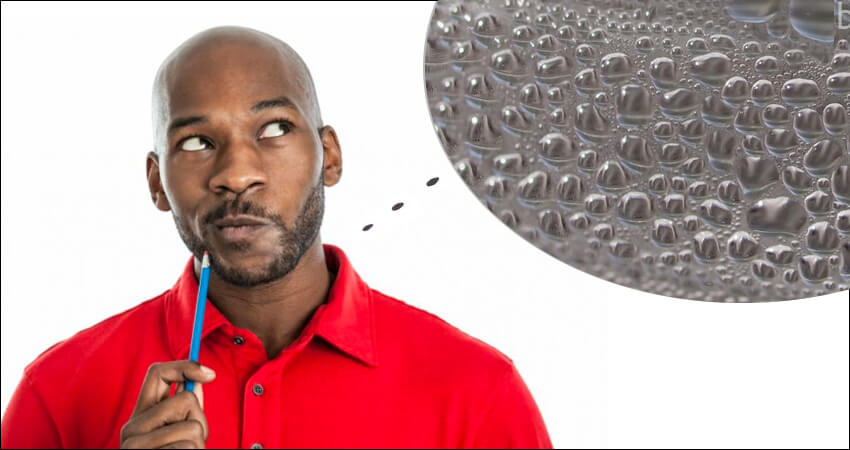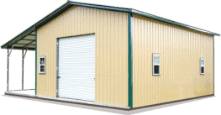25
How to Avoid Condensation Problem

Steel buildings are susceptible to problems caused by water condensation, therefore it is important to understand what’s the cause of these problems and the steps that can be taken to alleviate them. This guide will explain what condensation is, was causes it, and conclude with the best practices to prevent it from happening to avoid any damage to a metal building.
What is Condensation?
Condensation occurs when warm moist air comes into contact with cooler air or a cooler surface. Warmer air can hold more moisture than cooler air. The temperature of air when it holds as much moisture as possible is called the dew point. When the temperature of the air drops below the dew point, it releases some of the moisture it contains. This water can collect on surfaces and be a source of drips in metal buildings.
What Happens in Condensation?
The moisture in the air can come from a variety of sources including people using the building, the HVAC system, roof leaks, lack of insulation, improper insulation, lack of or improper installation of a vapor retarder, and air leaks from outside.
Warm moist air has a natural tendency to rise. If the air comes into contact with exposed surfaces that are cooler, such as the building walls, the roof-line, or struts, some of the moisture will collect on the surfaces.
Condensation is more likely to be a problem in areas where the outside temperature is frequently below 35ºF for extended periods. Condensation may be visible on exposed surfaces or happen in places where it cannot be seen. Condensation that is concealed may cause significant damage and problems with mold therefore care should be taken in metal building construction to avoid creating this problem.
Condensation in Un-Insulated Metal Buildings
Metal is an extremely good thermal conductor. This means that heat applied to one side of a metal surface will quickly pass to the other side, with very little interference. When one side has a temperature that is warmer, such as the interior of a metal building, the differential between the inside and outside temperature will cause condensation problems.
Any moisture that naturally evaporates toward the ceiling of such a structure will condense on the metal surface and may start to drip. This moisture can cause corrosion. The walls and fasteners can become weakened by oxidation, which shortens the useful life of a metal building.
Condensation in Poorly-Insulated Metal Buildings
Insulation that gets wet from condensation can cause additional problems. Fiberglass insulation does not perform well when it is wet. If moist, it may develop mildew and mold. If the insulation is wet and in contact with metal this increases the chance of corrosion.
Condensation Caused by Improper Installation of Insulation
To avoid problems from condensation, it is important to properly install insulation by using a good quality insulation that has a vinyl backing. This helps to make sure that warm moist air does not have any chance to come into contact with a cooler metal surface. It is important that insulation used for metal buildings has a vapor-retarding component that has a low perm rating so that water will not permeate pass the vapor barrier.
All joints and seams need to be completely sealed to make sure that moisture can not make the fiberglass wet. In metal buildings, the insulation needs to be completely continuous and cover all metal surfaces. Any exposed metal will cause problems.
How to Prevent Condensation Problems in Metal Buildings
The best practices to prevent condensation problems in metal buildings include insulating them properly with the right type of insulation that has a strong vapor barrier. The goal is to reduce interior moisture and have a relative humidity below 50%. An interior humidity of about 30% is ideal and achievable.
Things that help reduce moisture in the air include making sure the air can circulate by having proper ventilation and using a dehumidifier. Air circulation can be improved by using ceiling fans. Any heaters need to be vented to the outside. Ceiling vents can be used to help make sure the moist air can rise and then escape out the roof.
Vapor barriers should be used on the warmer side of the insulation and in crawlspaces, and also placed around attic openings, ductwork, and lighting fixtures. Any skylights should be covered by a clear vapor barrier. When insulation is installed properly, it helps control heat loss and keeps all interior surface temperatures above the dew point so moisture does not collect on them.
Control any moisture coming up from the concrete slab by using a vapor barrier. Make sure there is adequate drainage to divert any water away from the foundation.
Condensation is a natural process that can be controlled by following the best practices we have outlined. In this way, corrosion is minimized, which increases the effective life of the metal building and mildew or mold is not allowed to develop.
Get Started
It's fast and easy. Get your instant quote today!
BLOG TOPICS
- Garages (73)
- Farm Show (1)
- Building Components (1)
- Carports (29)
- Storage Sheds (15)
- Metal Buildings (5)
- Barns (25)
- Metal Homes (8)
- Metal Sheds (1)
- RV Covers (6)
- 12 Gauge Framing (7)
- Workshops (15)
- Eagles & Buildings (1)
- Reviews (2)
- Snowfall in the Southeast (2)
- Carports and Buildings Prices (1)
- Reality Of Discounted Buildings (2)
- Snow Removal (1)
- Offers (3)
- Condensation in Metal Buildings (2)
- News & Awards (11)
- Livestock sheds (5)
- Installations (15)
- Metal Buildings Applications (7)
- Customized Buildings (45)
- Carport Sizes (1)
- Facts (1)
- Certified Carports (2)
- COVID-19 (1)
- Prefab Metal Buildings (73)
- Metal Building Homes (6)
- Metal Building of the Week (130)
- Install of the week (34)
- Metal Building Extensions (1)
- Install of the month (6)
Metal Buildings
- Alabama
- Arizona
- Arkansas
- California
- Colorado
- Connecticut
- Delaware
- Florida
- Georgia
- Idaho
- Illinois
- Indiana
- Iowa
- Kansas
- Kentucky
- Louisiana
- Maine
- Maryland
- Massachusetts
- Michigan
- Minnesota
- Mississippi
- Missouri
- Montana
- Nebraska
- Nevada
- New Hampshire
- New Jersey
- New Mexico
- New York
- North Carolina
- North Dakota
- Ohio
- Oklahoma
- Oregon
- Pennsylvania
- Rhode Island
- South Carolina
- South Dakota
- Tennessee
- Texas
- Utah
- Vermont
- Virginia
- Washington
- West Virginia
- Wisconsin
- Wyoming
Metal Garages
- Alabama
- Arizona
- Arkansas
- California
- Colorado
- Connecticut
- Delaware
- Florida
- Georgia
- Idaho
- Illinois
- Indiana
- Iowa
- Kansas
- Louisiana
- Maine
- Maryland
- Massachusetts
- Michigan
- Minnesota
- Mississippi
- Missouri
- Montana
- Nebraska
- Nevada
- New Hampshire
- New Jersey
- New Mexico
- New York
- North Carolina
- North Dakota
- Ohio
- Oklahoma
- Oregon
- Pennsylvania
- Rhode Island
- South Carolina
- South Dakota
- Tennessee
- Texas
- Utah
- Vermont
- Virginia
- Washington
- West Virginia
- Wisconsin
- Wyoming
Metal Carports
- Alabama
- Arizona
- Arkansas
- California
- Colorado
- Connecticut
- Delaware
- Florida
- Georgia
- Idaho
- Illinois
- Indiana
- Iowa
- Kansas
- Louisiana
- Maine
- Maryland
- Massachusetts
- Michigan
- Minnesota
- Mississippi
- Missouri
- Montana
- Nebraska
- Nevada
- New Hampshire
- New Jersey
- New Mexico
- New York
- North Carolina
- North Dakota
- Ohio
- Oklahoma
- Oregon
- Pennsylvania
- Rhode Island
- South Carolina
- South Dakota
- Tennessee
- Texas
- Utah
- Vermont
- Virginia
- Washington
- West Virginia
- Wisconsin
- Wyoming
- 100x100 Metal Building
- 12x12 Metal Shed
- 12x20 Carport
- 12x24 Carport
- 12x30 Carport
- 16x20 Carport
- 18x20 Carport
- 20x20 Carport
- 20x20 Metal Building
- 20x30 Carport
- 20x30 Metal Building
- 20x40 Carport
- 20x40 Metal Building
- 24x24 Carport
- 24x24 Garage
- 24x30 Carport
- 24x30 Metal Building
- 24x30 Metal Garage
- 24x36 Metal Building
- 26x30 Metal Building
- 30x30 Carport
- 30x30 Garage
- 30x30 Metal Building
- 30x40 Carport
- 30x40 Garage
- 30x40 Metal Building
- 30x40 Storage Building
- 30x50 Metal Building
- 30x60 Metal Building
- 40x100 Metal Building
- 40x40 Metal Building
- 40x60 Metal Building
- 40x80 Metal Building
- 50x100 Metal Building
- 50x50 Metal Building
- 50x80 Metal Building
- 60x100 Metal Building
- 60x120 Steel Building
- 60x60 Metal Building
- 60x80 Metal Building
- 80x100 Metal Building
- All Steel Carports
- American Building Network
- American Custom Carports
- American Steel Carports
- Arkansas Carports
- Best Choice Metal Structures
- California All Steel
- Carports Outlet
- Central Texas Metal Buildings
- Coast To Coast Carports
- Custom Steel Structures
- Dreams Carports and Buildings Inc
- East Coast Carports
- Enterprise Steel Structures
- Infinity Carports
- Interstate Steel Structures
- Long Horn Buildings
- Midwest Steel Carports
- NC Structures
- New Team Carports
- Northside Metal Carports
- Quality Carports
- Rhino Carports
- Safeguard Metal Buildings
- Southern Steel Buildings Inc.
- Steel Buildings and Structures
- Tennessee Steel Buildings
- Tubular Building Systems
- Ultimate Metal Buildings
- United Structures
- USA Carports



